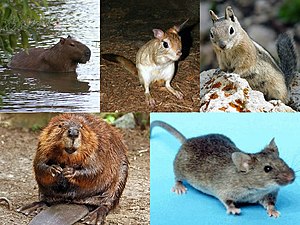 |
| Clockwise from top: capybara, spring hare, golden-mantled ground squirrel, house mouse and beaver representing the suborders Hystricomorpha, Anomaluromorpha, Sciuromorpha, Myomorpha, and Castorimorpha, respectively. |
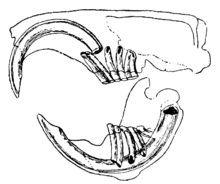 |
| Drawing of typical rodent tooth system. The front surface of the incisors is hard enamel, whereas the rear is softer dentine. The act of chewing wears down the dentine leaving a sharp, chisel-like edge |
 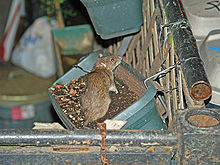 |
| Wood mouse with its long whiskers (left). Brown rat in a flowerbox. Some rodents thrive in human habitats (right). |
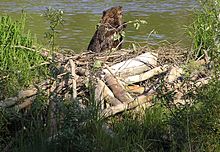  |
| Some rodents, like this North American beaver (left) with its dam of gnawed tree trunks and the lake it has created, are considered ecosystem engineers. Eastern chipmunk carrying food in cheek pouches (right). |
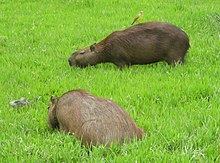 |
| Capybara grazing |
 |
| Prairie dog "town" |
  |
| Nepotistic species such as house mice (left) rely on urine, feces and glandular secretions to recognize their kin. Three degus keeping warm at Artis Zoo, Netherlands (right). Degus have a complex vocal repertoire. |
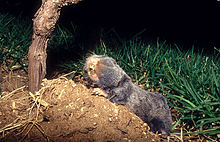  |
| The Middle East blind mole rat uses vibrational communication (left). The Cape ground squirrel is an example of a promiscuous rodent (right). |
Rodents are mammals of the order
Rodentia, which are characterized by a single pair of unremittingly growing incisors in each of the upper and lower jaws. About forty percent of all mammal species are rodents; they are found in vast numbers on all continents except Antarctica. They are the most diversified mammalian order and live in a variety of terrestrial habitats, including human-made environments. There are species that are arboreal, fossorial (burrowing), and semi-aquatic. Well-known rodents include mice, rats, squirrels, prairie dogs, porcupines, beavers, guinea pigs, hamsters, and capybaras. Other animals such as rabbits, hares and pikas were once included with them, but are now considered to be in a separate order, Lagomorpha.
Most rodents are small animals with robust bodies, short limbs and long tails. They use their sharp incisors to gnaw food, excavate burrows and defend themselves. Most eat seeds or other plant material, but some have more varied diets. They tend to be social animals and many species live in societies with complex ways of communicating with each other. Mating among rodents can vary from monogamy, to polygyny, to promiscuity. Many have litters of underdeveloped, altricial young, while others have precocial young that are relatively well developed at birth.
Rodents have been used as food, for clothing, as pets and as laboratory animals in research. Some species, in particular the brown rat, the black rat, and the house mouse are serious pests, eating and spoiling food stored by humans, and spreading diseases. Accidentally introduced species of rodents are often considered to be invasive, as they sometimes threaten the survival of native species, such as island birds, previously isolated from land-based predators.
Science G5, 1st smester
First August, 2015















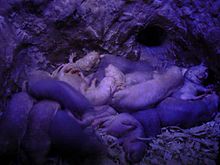

No comments:
Post a Comment